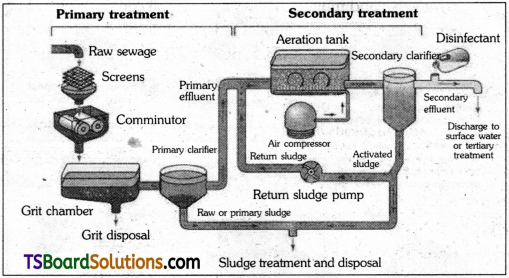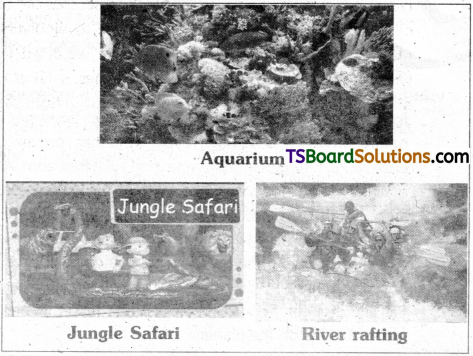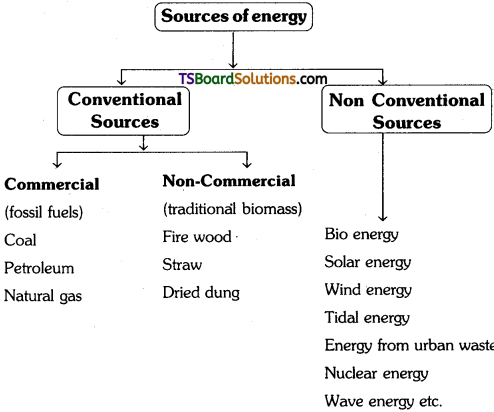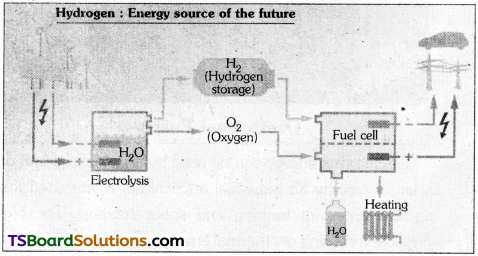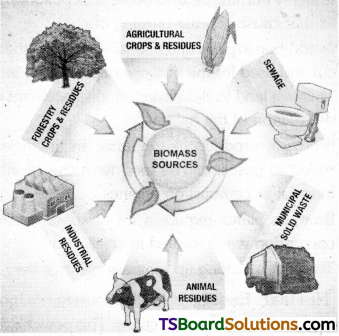Telangana TSBIE TS Inter 1st Year Environmental Education Study Material 7th Lesson Types, Sources and Effects of Pollution Textbook Questions and Answers.
TS Inter 1st Year Environmental Education Study Material 7th Lesson Types, Sources and Effects of Pollution
Essay Questions
Question 1.
Define Environmental pollution. Explain sources, effects and control measures of air pollution.
Answer:
Environmental pollution can be defined as any undesirable change in the physical, chemical or biological characteristics of any components of the environment (air, water, soil) which can cause harmful effects on various forms, of life or property. In other words, it is the contamination of air, water or soil by substances that are harmful to living beings. The major forms of pollution are air pollution, water pollution and soil pollution. Noise pollution, thermal pollution, nuclear pollution and plastic pollution too are types of pollution. The contamination of the environment by the generation and improper disposal of garbage and other wastes is sometimes referred to as waste pollution. .
Air pollution :
Air pollution is the introduction of particulates or harmful gases into the earth’s atmosphere, causing undesirable effects on man and his environment. Put simply, it is the fouling of the air by harmful substances.
Sources of Air Pollution :
The sources of air pollution are natural and anthropogenic (man-made). Natural sources include volcanic eruptions, forest fires, sea salt sprays and pollen grains. Man-made sources include industrial units, vehicular emissions and agricultural activities.
Indoor air pollution can be more dangerous than outdoor air pollution

Air pollutants and their sources
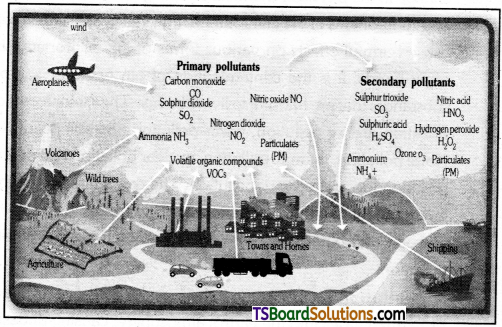
Effects of Air Pollutants (substances that pollute the air)
| Air pollutant | Typical source | Effects |
| Dust (or) Particulars | Mines and quarries, pottery and ceramics, factory stacks.power stations and civil construction works. | On human beings- respiratory diseases; diseases like silicosis.
On property- soiling effect and corrosion. |
| Sulphur dioxide | Power houses, sulphuric acid plants, petroleum industry, oil refining, domestic use of fuel. | On human beings-suffocation, irritation of throat and eye, respiratory diseases.
On vegetation- destruction of sensitive crops and reduced yield.
On property- corrosion |
| Nitrogen dioxide | Acid manufacture, automobile exhaust, explosive industry | On human beings-irritation, bronchitis, edema of lungs.
On property- darkening of painted surfaces, corrosion. |
| Air pollutant | Typical source | Effects |
| Hydrogen sulphide | Viscose rayon plants, petroleum industry, sewage treatment, tanning industry, dye manufacture. | On human beings-irritation of respiratory passages, danger of respiratory paralysis and asphyxiation. |
| Hydrogen fluoride | Fertilizer industry, chemical industry, aluminum industry. | On human beings-irritation to skin, eyes and mucous membranes, fluorosis, mottling of teeth, respiratory diseases.
On vegetation-destruction of crops On animals-fluorosis in cattle which graze on such vegetation. |
| Carcinogenic hydrocarbons | Organic chemical, industry, vehicular traffic specially automobiles | On human beings cancer. |
| Carbon monoxide | Fuel gases, automobile exhaust, mines, blast furnaces. | On human beings accident, susceptibility due to poisoning effect of gas |
| Oxidants | Photo-chemical products such as those used in photography, xerox machines, optical whit- eners used in washing powder by intense UV radiation. | On human beingslung irritation. On vegetation destruction of vegetation. On property cracking of rubber and deterioration of textiles; smog for mation. |
National Air Quality Index :
There are six AQI categories, namely Good, Satisfactory, Moderately polluted, Poor, Very Poor and Severe. Each of these categories is decided based on ambient (existing in the surroundings) concentration values of air pollutants and their likely health impacts, known as health breakpoints. These pollutants include particulate matter, nitrogen dioxide, sulphur dioxide, carbon monoxide, ozone, ammonia and lead.
AQI categories and health breakpoints for the eight pollutants :
Air Quality Index is a tool for effective communication of air quality status to people in terms which are easy to understand. It transforms complex air quality data of various pollutants into a single number (index value), nomenclature and colour.
Control of Air Pollution :
- Locating of industries away from residential areas.
- Modification of process and/or equipment.
- Using low sulphur coal.
- Controlling vehicular pollution.
- Using mass transport system.
- Using non-conventional sources of energy.
- Planting more trees and indoor plants.

Question 2.
Explain about noise pollution.
Answer:
Noise Pollution :
Unpleasant and unwanted sound is called Noise. The intensity of sound is expressed in decibels (dB).
According to the World Health Organization, sound levels less than 70 dB do not cause damage to living organisms, regardless of how long or consistent the exposure is. Exposure for more than 8 hours to constant noise beyond 85 dB may be hazardous.

Sources of Noise Pollution :
The main sources of noise are various household sources, agriculture machines, modes of transportation (like air, road, rail transportation), industrial operations, construction activities, defence equipment, loud speakers, celebrations, electric home appliances and the bursting of crackers.
Effects of Noise :
i) Interferes with human communication :
In a noisy area communication is severely affected.
ii) Hearing damage :
Noise can cause temporary or permanent hearing loss depending on the intensity and duration of the sound level.
iii) hysiological and Psychological changes :
Continuous exposure to noise may result in hypertension, insomnia (sleeplessness), gastrointestinal and digestive disorders, peptic ulcers, blood pressure changes, behavioral changes and emotional changes.
Ambient Air Quality Standards in respect of Noise recommended by CPCB :

Day time : 6.00 a.m. to 10.00 p.m. (16 hours); Night time : 10.00 p.m. to 6.00 a.m. (8 hours)
Noise Pollution during Deepawali :
Noise quality is affected by the fireworks during Deepawali festival. Deepawali is a festival of lights. It is celebrated with great enthusiasm all over India during the month of October or November (onset of winter).
Deepawali is celebrated by bursting crackers and fireworks, which increase the pollution load in terms of air and noise quality. Fireworks contain chemicals such as aluminium, potassium nitrate, copper compounds, antimony sulphide, arsenic, sulphur, manganese, potassium perchlorate, chrontium nitrate and barium nitrate.
Control of Noise Pollution :
- Reduction of noise at source.
- Proper oiling of machinery.
- Use of sound absorbing silencers.
- Planting more trees.
- Banning of crackers.
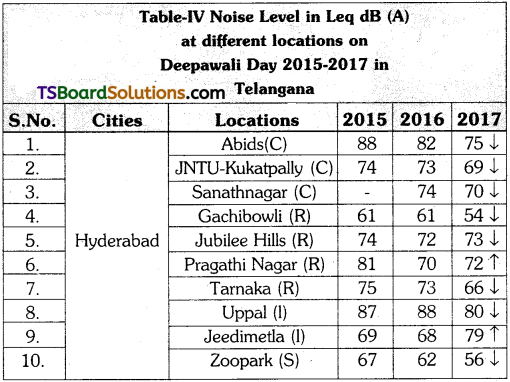
Question 3.
Explain water pollution.
Answer:
Water pollution is defined as the alteration of physical, chemical and biological characteristics of water resulting in harmful effects on life systems.
Sources of water pollution :
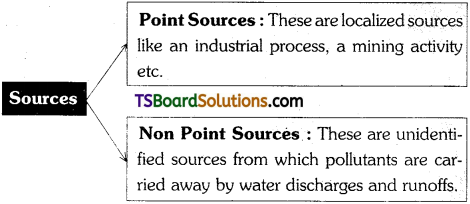
Types of Water Pollution :
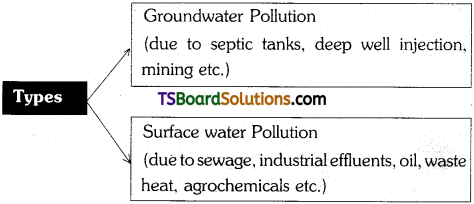
Effects of Water Pollution :
- Sewage and domestic wastes affect human health resulting in diseases such as cholera, typhoid, dysentery.
- Industrial discharges contain metals like lead, mercury and cadmium, which have a deleterious impact on life systems. They also contain harmful chemicals like arsenic.
Lead – damages liver end kidneys.
Arsenic – lung cancer, ulcers in gastro intestinal tract.
Cadmium- diarrhea, kidney cysts, bone deformation. Mercury – neurological disorders, - Agricultural discharges include fertilizers and pesticides which are toxic to both aquatic and human life.
Marine pollution can mean plastic litter, other litter such as glass bottles and cans, oil and chemical spills or polluted stormwater from drains and rivers flowing into the sea.

Control of Water Pollution :
- Restricted use of pesticides.
- Prevent run-off of fertilizers and manure (washing away of fertilizers and manure into nearby water sources or leaching into ground water).
- Stop entry of sewage into water bodies.
- Stop letting out industrial effluents into water bodies.

Question 4.
Write about Soil Pollution.
Answer:
Soil pollution is defined as the presence of toxic chemicals (pollutants or contaminants) in soil, in high enough concentrations to pose a risk to human health and/or the ecosystem. Causes of Soil Pollution : There are two main causes through which soil pollution is generated: anthropogenic (manmade) causes as natural causes. .
Man-made Soil Pollutants :
Man-made soil pollution is usually caused by the improper disposal of waste coming from industrial or urban sources, industrial activities and agricultural pesticides and also due to accidental spills.
Natural Soil Pollutants :
Natural processess can lead to an accumulation of toxic chemicals in the soil. This type of contamination has been accorded only in a few cases, such as the accumulation of high levels of perchlorate in soil from the Atacama Desert in Chile, a type of accumulation which is purely due to natural processes in arid environments.
Effects of Soil Pollution :
- Sewage sludge contains many pathogenic organisms, bacteria, viruses and intestinal worms which cause various diseases.
- Industrial discharges like acids, alkalis, pesticides, insecticides, weedicides and fungicides affect soil fertility by causing changes in the physical, chemical and biological properties.
- There is an increase in salinity when soil gets polluted by nitrate and phosphate deposits used in fertilizers and pesticides. Plants cannot grow properly in saline soil and they can be poisonous to humans when consumed.
- Crops grown on polluted soils become unfit for human consumption as they become poisoned with chemicals and metals that have leached into the soil from industries.
- Soil pollution causes water and air pollution. Water contamination takes place when toxic chemicals from the soil leach into groundwater. Air is fouled by toxic chemicals and gases that are discharged into the air by polluted soil.
- Radioactive wastes discharged form industries and laboratories into the soil can cause neurological damage, loss of hair and nausea.
Control of Soil Pollution :
- Effluents should be properly treated before being discharged into the soil.
- Wastes should be properly collected and disposed of by appropriate methods.
- Recovery of useful products from wastes should be encouraged.
- Biodegradable organic waste should be used for generation of biogas.
- Microbial degradation of biodegradable substances.
Question 5.
Write about thermal, nuclear and plastic pollution.
Answer:
Thermal Pollution :
Thermal pollution is the industrial discharge of heated water into a river, lake or other body of water, causing a rise in temperature that endangers aquatic life and harms others who use the water.
Effects of Thermal Pollution :
- The dissolved oxygen of the content of water decreases.
- Fish migration is affected due to formation of various thermal zones.
- Composition of flora and fauna changes as sensitive species are replaced by species which are temperature tolerant.
Control of Thermal Pollution :
The following methods can be employed for control:
- Cooling ponds
- Cooling towers
- Spray ponds or reservoirs in which warm water, usually from thermal plants, is cooled before reuse.
Nuclear Pollution :
The term refers to the risk or danger to human health or the environment posed by radiation emanating from the atomic nuclei of a given substance, or the possibility of an uncontrolled explosion originating from a fusion or fission reaction of atomic nuclei.
Sources of Radioactivity :
i) Natural Sources :
Cosmic rays from outer space, radioactive radon – 222, soil, rocks, air, water and food, which contain one or more radioactive substances.
ii) Anthropogenic Sources :
Nuclear power plants, nuclear accidents, X-rays.
Effects of Radiation :

Control of Nuclear Pollution :
- The site of the nuclear power plant should be carefully chosen after studying long term and short term effects.
- Proper disposal of radioactive wastes from the laboratory should be undertaken.
VII) Plastic Pollution :
Plastic pollution is the accumulation of plastic products in the environment to the extent that it adversely affects wildlife, wildlife habitat, or humans. Plastic is cheap and durable. It is present in thousands of articles we use in daily life, whether in furniture or toys, carpets or containers, diapers or mobile phones. ‘Use and throw’ disposable plastic plates and glasses, plastic articles such as bottled drinks, straws, shopping bags and packaging material are commonly used even in developing countries.
Plastic may be convenient to use but it is very harmful to the environment. Landfill areas are filled with mounds of plastic. As plastic is not biodegradable, it remains as debris in the soil or is washed away into the water and remains there for hundreds of years without decomposing. It releases harmful chemicals into the soil. These chemicals seep into groundwater and harm species that drink the water. Plastic fishing nets used for trawling operations lie submerged in water and leak toxins. Sea animals get entwined in these nets and die.
It is estimated that since the 1950s more than 6 billion tonnes of plastic have been produced, of which only a fifth has been recycled or incinerated. Plastic is clogging the sewage system and leaching harmful chemicals into the soil, air and water. It chokes marine life and kills land animals which ingest it by mistake. Plastic is suspected of being a causative factor in several diseases which afflict human beings, including cancer. It can also cause genetic mutations.
Given below are diagrams which point out the harmful effects of plastic and the measures we can take to reduce plastic pollution.

India hosted the global World Environmental Day celebrations on 5 June 2018. “Beat Plastic Pollution”, the theme for World Environment 2018, urges governments, industry, communities, and individuals to come together and explore sustainable alternatives and urgently reduce the production and excessive use of single- use plastic which pollutes our oceans, damages marine life and threatens human health.
The term
“plastic” derives from the Greek
“plastikos,” meaning fit for molding, and
“plastos,” meaning molded.
Plastics are polymers (meaning “many parts” in Greek),
‘ which are basically substances or molecules made up of many’
repeating molecular units, known as monomers (meaning “one
part” in Greek).
Monomers of hydrogen and carbon – hydrocarbons – are
linked together in long chains to form plastic
Dolymers. The raw hydrocarbon material for mosj,
synthetic plastics is derived
from petroleum etc. |
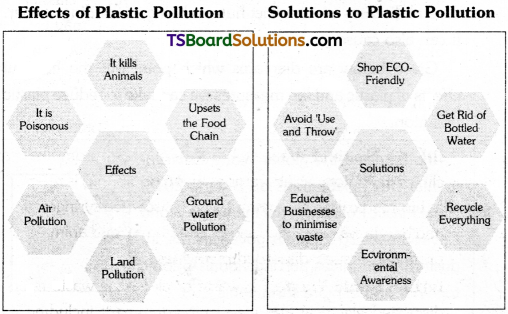

Question 6.
Write about solid waste pollution.
Answer:
Waste can be defined as a material or substance that is eliminated or discarded as it is no longer useful or required after the completion of a process. Waste pollution is the fouling of the environment by wastes. Ther term ‘solid waste’ refers to any material that is discarded by being abandoned or thrown away. It includes garbage, refuse, sludge and discarded materials. It may consist of not only solids but semisolids, liquids and gaseous substances too. Solid waste can be classified as .municipal, industrial, agricultural, medical, mining waste and sewage sludge.
Different Types of Wastes :
i) Municipal Solid Waste :
Municipal waste contains a variety of discarded materials like polyethylene bags, empty metal and aluminum cans, scrap metals, glass bottles, waste paper, diapers, cloth/rags, and food waste.
ii) Industrial Waste :
Such wastes are generated due to processes and activities pertaining to industry, manufacturing, mining, and agriculture. Industrial waste can be classified as hazardous or non-hazardous. Hazardous waste may be flammable, corrosive or reactive, such as chemical solvents, metals, and paper products. They.should be disposed of very carefully. Non-hazardous industrial wastes include sludge and demolition debris such as bricks. They are usually accepted in landfills.
iii) Bio-Medical Waste :
Waste in any form from hospitals, clinics, pathological laboratories, and blood banks is referred to as bio-medical waste. Examples are: discarded syringes, gloves, and bandages, unwanted samples of human and animal blood, urine, and tissues, discarded medicines.
iv) Electronic Waste :
E-waste or electronic waste refers to discarded electrical and electronic equipment including their components, consumables, and spares. Examples are computers, TVs, and mobile phones which have been discarded as they have reached the end of their ‘useful life’.
v) Construction and Demolition Wastes :
Wastes or debris generated during construction, demolition or renovation of buildings. The wastes include concrete, brick, wood, steel and plaster.
Effects of Waste Pollution :
i) Municipal solid wastes pile up on the roads due to improper disposal. This type of dumping allows biodegradable materials to decompose under uncontrolled and unhygienic conditions. The garbage produces a foul smell and is a breeding ground for various types of insects and harmful micro – organisms, besides spoiling the aesthetics of the site.
5 R concept for Waste Management

ii) Industrial solid wastes are sources of toxic metals and hazardous wastes. The harmful chemicals discharged into the water, land and air have adverse effects on human health, besides fouling the environment.
iii) Toxic substances may leach or percolate to contaminate the ground water.
iv) Various types of wastes like cans, pesticides, cleaning solvents, batteries (zinc, lead or mercury), radioactive materials, plastics and e-waste are mixed up with paper, scrap and other non-toxic materials which can be recycled. Burning of some of these materials produces toxic gases which have the potential to cause various types of ailments including cancer.
Handling of Waste :
Waste management is the collection, transportation and disposal of garbage, sewage and other waste material. The adverse effects of solid wastes can be minimized through proper waste management. It is necessary to create public awareness through information, education and communication campaigns and to educate those who generate waste on the following :
- not to litter.
- minimise generation of waste.
- reuse waste to the extent possible.
- practice segregation of waste into bio-degradable, non-biodegradable (recyclable and combustible), sanitary waste and domestic hazardous wastes at Source.
- practise home composting, vermicomposting, bio-gas generation and community level composting.
- wrap sanitary waste securely in pouches and place the same in the bin meant for non-biodegradable waste.
- store segregated waste at source in different bins.
- hand over segregated waste to waste pickers, waste collectors, recyclers or waste collection agencies.
- pay monthly user fees to waste collectors or local bodies for sustainability of solid waste management.
- stop land filling or dumping of mixed waste.
- allow only non-usable, non-recyclable, non-biodegradable, non-combustible and non-reactive inert waste to go to the sanitary landfill.
SEGREGATE WASTE AT HOME
Hazardous waste :
Tube lights & bulbs, Batteries, Cleaning agents, Paints, Oils, Aerosol cans, Cosmetics, Insecticides, Medicines, Syringes, Thermometers, and E-waste (computer and mobile parts)
Debris :
Dust, Drain silt, Ashes, Broken bricks, Broken glass, Construction waste, Demolition waste
Sanitary Waste :
Sanitary napkins, Disposable diapers, Bandages, and Any material contaminated with blood
Dry Waste :
Glass, Wire, Cloth, Leather, Rubber, Thermacol, Metal, Paper Plastic, Wood, Rubber, Rexine, Leather, Fabric.
Garden waste :
Fallen leaves, Trimmed branches, Lawn trimming, Weeds
Wet Waste :
Cooked food, Uncooked food, Fruits, Vegetable peels, Flower waste
![]()
![]()

